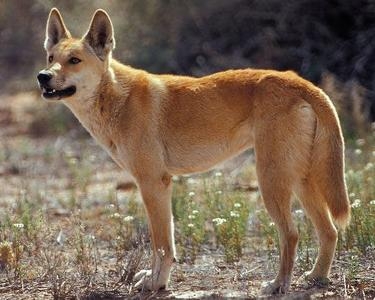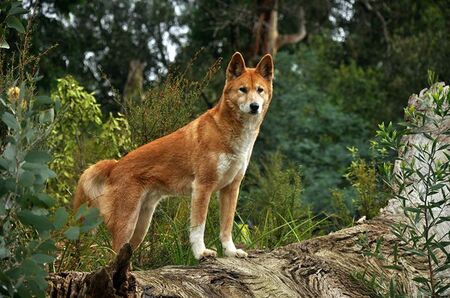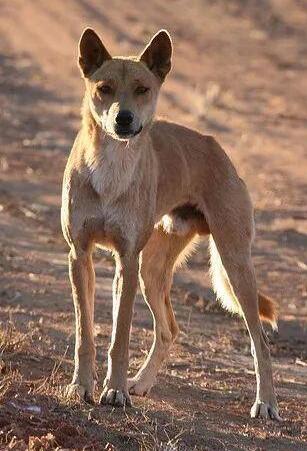Canis lupus dingo
IUCN
LCBasic Information
Scientific classification
- name:Canis lupus dingo
- Scientific Name:Canis dingo,Australian Dingo,Dingo,Canis macdonnellensis Matschie,Canis lupus familiaris dingo Meyer,Canis dingo Meyer,Canis familiaris dingo,Canis antarticus Kerr,,Canis familiaris australasiae Desma
- Outline:Carnivora
- Family:C.l.dingo C.lupus Canis Canidae Carnivora Mammalia Chordata
Vital signs
- length:81-111 cm
- Weight:11-22kg
- lifetime:10-15years
Feature
A dog breed that has never been fully domesticated[source request]. One reason is their remoteness and isolation, another reason is due to the lack of human intervention. They do not have equidistant teeth and a shortened snout, which distinguishes them from other dogs and their ancestor, the Iranian wolf. Like wolves, female Dingos have only one breeding season per year.
Distribution and Habitat
The dingo population is not limited to Australia. It is also distributed in China, Myanmar, Vietnam, Thailand, the Philippines, Cambodia, India, Laos, Indonesia, Malaysia, and Papua New Guinea. Wild
populations mainly live throughout Australia, and some communities are scattered in other parts of Southeast Asia and New Guinea. This species is not limited to Australia. Wild populations mainly live in Australia, and some communities are scattered in other parts of Southeast Asia and New Guinea.
It inhabits a variety of environments, including tropical alpine swamps above 3,800 meters above sea level and tropical forests, grasslands, grasslands, deserts, plateaus, wetlands and other natural environments. It has a very strong adaptability, and some dare to move around near villages. It is found throughout the snow-capped peaks covered with temperate forests in eastern Australia, the arid deserts in central Australia.
Appearance
A medium-sized canine species, males are significantly taller than females, weighing 9.6-19.4 kg, 885-920 mm long, and 470-670 mm at the shoulder. Dingos have elegant long legs and are very agile, with excellent movement, speed, and endurance. The fur is rich in color, with a typical sandy color overall, including ginger, gold, red, brown, cream, and even pure black and pure white individuals have been found, and the appearance is no different from that of ordinary domestic dogs. The frosty hair on the chest, feet, and tail tip is lighter in color. Some dingos have black-brown and white markings on their bodies.
Details

The Australian dingo (scientific name: Canis lupus dingo, Canis dingo) is a mammal belonging to the Canidae family. It is also known as Dingo, Australian wild dog, Australian dingo, and Australian wild dog. It is a group of prehistoric wild dogs. It is a secondary subspecies of wolf and belongs to the genus Canis in biological classification. Males are obviously taller than females, with a body length of 81-111 cm, a tail length of 31 cm, a shoulder height of 40-65 cm, a male weight of 12-22 kg, and a female weight of 11-17 kg. It has elegant long legs and is very agile. Its movement, speed, and endurance are excellent. The fur is rich in color, and the overall color is typical sandy, including ginger, gold, red, brown, and milky white. Even pure black and pure white individuals have been found. The appearance is no different from that of ordinary domestic dogs.
The earliest dingo skull was found in Vietnam and is about 5,500 years old. Fossils of dingoes have been found in other parts of Southeast Asia from 5,000 to 2,500 years old, while the earliest record in Australia is 3,500 years ago. A 14,000-year-old dingo-like skeleton was found in Israel.
Morphological characteristics
The dingo is a medium-sized canine species. Males are significantly taller than females, weighing 9.6-19.4 kg, 885-920 mm in length, and 470-670 mm in shoulder height. The dingo has elegant long legs and is very agile. Its movement, speed and endurance are excellent. The fur is rich in color, and the overall color is typical sandy, including ginger, gold, red, brown, creamy white, and even pure black and pure white individuals have been found. The appearance is no different from that of ordinary domestic dogs. The frosty hair on the chest, feet and tail tip are lighter in color. Some dingoes have black-brown and white markings on their bodies. The bushy tail is more wolf-like than other wild dogs, and the species has large canine teeth, which are only found in carnivores.
The Australian dingo is often larger than the Asian wild dog "jackal". The wild dogs in Southeast Asia are also usually ginger-colored, but there are more pure black individuals found in Southeast Asia than in Australia.
Distribution range
The dingo population is not limited to Australia. It is distributed in China, Myanmar, Vietnam, Thailand, the Philippines, Cambodia, India, Laos, Indonesia, Malaysia, and Papua New Guinea. Wild populations mainly live in various parts of Australia, and some groups are scattered in other parts of Southeast Asia and New Guinea.
This species is not limited to Australia. The wild population mainly lives in Australia, and some groups are scattered in other parts of Southeast Asia and New Guinea.

Habitat
The dingo lives in a variety of environments, including tropical alpine swamps above 3,800 meters above sea level and natural environments such as tropical forests, grasslands, grasslands, deserts, plateaus, and wetlands. It has a very strong adaptability and some dare to move around villages. Dingos are found in the snowy peaks of temperate forests in eastern Australia, in the arid deserts of central Australia, where they are found near deep wells dug by ranchers for their cattle, and in the tropical wetlands and forests of northern Australia. The pups are born in burrows, rabbit holes, and rock caves, and live close to water sources. Dingos in Asia live near villages, where people provide food and shelter in exchange for protection of their homes.
Lifestyle
Dingos have the same behavioral characteristics as most primitive wild dogs, usually living alone during the non-mating season, and often organize in family forms to form close bonds to hunt large prey. Each group is stable at 3-12, with a strict hierarchy and various degrees of social interaction. Usually led by a couple, with males higher than females. Dingos with lower rankings will show aggression towards each other when competing for ranking. There is little interaction between competitors. The tribe occupies a territory of 10-20 square kilometers and has a strong sense of territory.
Dingos live in groups, are typical carnivores, forage at dawn and dusk, and rest in the shade during the midday heat. Dingos generally hunt small prey, and hunt in pairs or groups when chasing large prey such as kangaroos, sheep and calves. They will attack prey from multiple directions until they lose balance before attacking. 60% of the food of the Australian population is high-protein meat, and the diet is very rich, including: rabbits, rats, possums, wallabies, kangaroos, sheep, calves (cattle), birds, reptiles, carrion and human garbage. Dog packs often cooperate to hunt large prey such as kangaroos, wombats, sheep, calves, monitors, etc. The rest is birds and reptiles. Kangaroos, wallabies, sheep and calves may also be eaten, but their diet is mostly small animals, especially the introduced European rabbit. The Asian population is closely related to human life, and most of their food is composed of domestic garbage, including cooked rice, fruit and a small amount of chicken, fish or crab meat. They will also look for other foods such as carrion. Such flexible eating habits make them able to survive in various ecological environments. In Thailand, this species was observed to hunt lizards and mice.
The main natural enemies are humans and crocodiles, as well as domestic dogs and jackals. Sometimes dingoes from different groups will kill each other. Eagles will also catch small dingoes.
Group composition and social level: Dingoes are generally organized into groups in the form of families, and there is a complex social structure between families. A common dingo group is often led by a pair of adult male and female dogs, plus their children. Such a family structure can ensure the stability and order of the group.
Dingoes like to live near water, and they have learned to store water over the years. In many cases, if the water source is limited, the stronger dingoes will have water to drink, while the older and weaker dingoes can only thirst.
Reproduction method
Dingoes live in small groups, and there is a strict hierarchy in the group. Only a pair of dominant dingoes in each group can reproduce offspring, and other dingoes help the leader to raise cubs together. The female leader sometimes kills pups that are not her own. The behavioral characteristics are more like primitive dogs. One litter is produced each year. The breeding season depends on the latitude and seasonal changes. The Australian wild dogs mate in March and April, while the Asian population postpones to August and September. The average gestation period of the female dog is 63 days, with 1-10 pups per litter, usually 4-5 pups. The puppies are carefully cared for by all members. When they are three weeks old, the puppies walk out of the cave for the first time. Eight weeks after birth, the puppies are weaned and leave the cave completely. They mainly roam within three kilometers of the cave accompanied by adult dogs. When the newborn puppies are 9-12 weeks old, the adult dogs in the group will bring them large pieces of solid food. Usually the adult dogs swallow the food whole and regurgitate it to the puppies. The lactation period is about 2 months. They can move independently at 3-4 months old. They are sexually mature at around 2 years old. The average lifespan is 10 years, and the highest record in captivity is 15 years.

This is not the first time that Australian wild dogs have injured people. On April 17, 1980, a 10-year-old boy was killed by a dingo; in March 1998, two British tourists were attacked by dingoes on Fraser Island; in April 1998, a 13-month-old baby and a 3-year-old Norwegian boy were bitten by dingoes on the island; on February 17, 1999, a German tourist was also bitten on the island. According to the island's managers, they have received nearly 300 reports of dingoes injuring people. It is estimated that there are about 200 dingoes living on the island, and the number of dingoes in Australia is between 200,000 and 350,000. Wear a dog cover and leash to prevent injuries. Australia has announced a new pet welfare protection law, which stipulates that owners who fail to provide dogs with shelter, clean food and water will face heavy fines. It also stipulates that owners cannot restrict dogs for more than 24 hours, and must walk their dogs for 2 hours within 24 hours. If they restrict dogs for more than 24 hours, they will face a fine of up to 4,000 Australian dollars, about 20,000 RMB.
From this regulation, it can be seen that Australia is no longer satisfied with letting dogs eat and drink enough. The new regulations are to guarantee "dog rights", which is the same as "human rights".
In addition, other regulations issued together with this regulation are more stringent. Pet shop owners and pet breeders will be fined 48,000 Australian dollars, about 240,000 RMB, and sentenced to 3 years in prison if they beat dogs or other violent behaviors against dogs!








